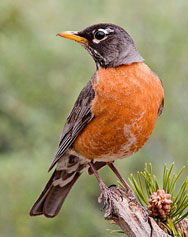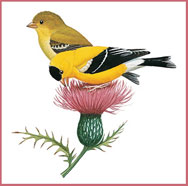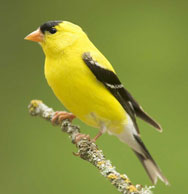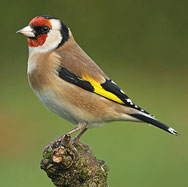Bird on a Box
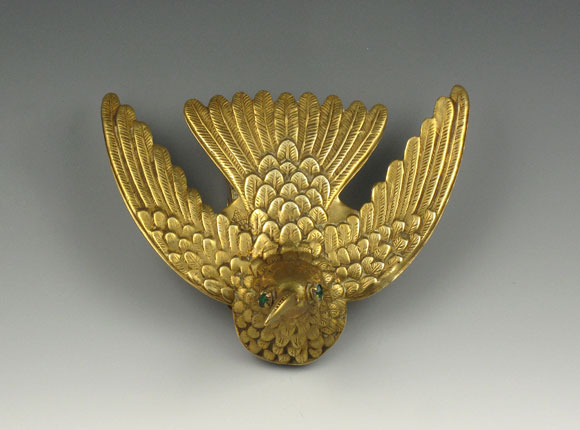
Needle case without gemstones on the wings and with green gemstone eyes
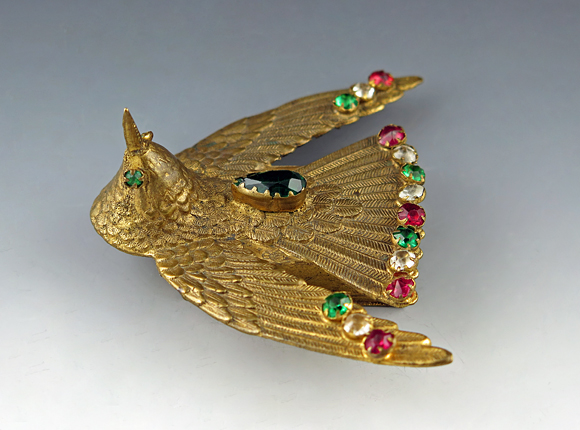
.
Needle case with red, green and white gemstones on the wings and with green gemstone eyes
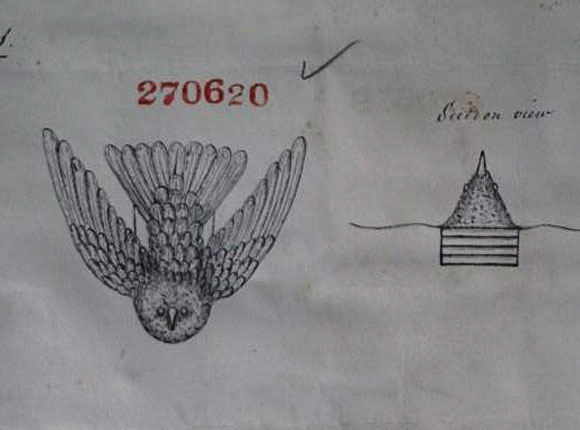
Design Representation
Design Details
Needle Case Type: |
Figural |
Patent/Registered to: |
Henry Jenkins & Sons - Birmingham |
Patent/Design Representation #: |
Ornamental Class1: Metal: #270620 |
Patent/Design Registration Date: |
February 21, 1873 |
Location of Patent/Design Registration: |
The National Archives (TNA) - Kew, UK |
Reference #: |
TNA Representation - BT 43/33/270620 |
Dimensions: |
7.5 x 3.5 x 5.5 |
Material: |
Brass. (NOTE: This is one of only two Avery style designs which used solder to attach the needle packet holders to the figural design. The other one is the Butterfly Filigree which was also patented by Jenkins. Solder was also used to attach the gemstone frames for the eyes, back and wings to the Bird on a Box.) |
Name Variations: |
a) W. Avery & Son - Redditch |
Other Variations: |
a) Without gemstones on the wings; with No. 300 and patented Feb. 24. 73 stamped on the bottom next to the name variation. |
Additional Photographs
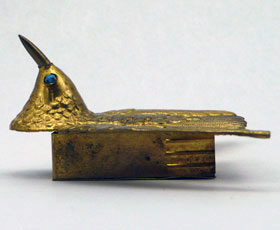
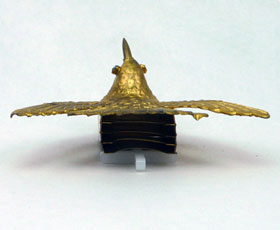
Needle case without gemstones except turquoise eyes. Side and back views (photos courtesy on Lynda Herrod)
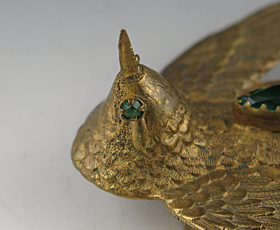
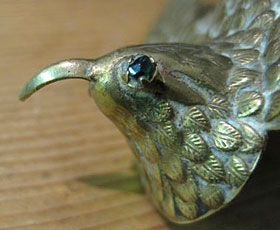
Needle case without gemstones. Left: green-eyed version with straight beak. Right: green-eyed version with curved beak (photo from eBay)
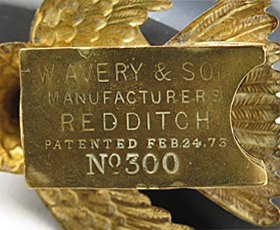
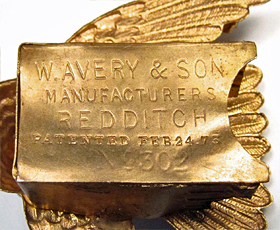
Left: Bottom of the needle case without gemstones with "No 300" and the Avery name. Right: Bottom of the needle case with gemstones with "No 302" and the Avery name (photo from Hans Gruchow).
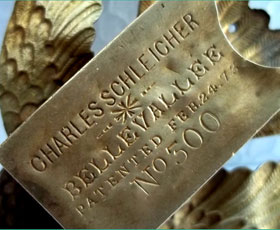
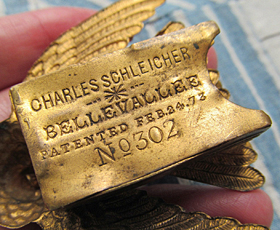
Left:: Bottom of the needle case without gemstones with "No 300" and the Schleicher name (photo from eBay). Right: Bottom of the needle case with gemstones with "No 302" and the Schleicher name (photo from Etsy).
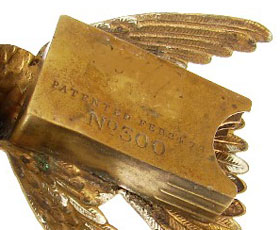
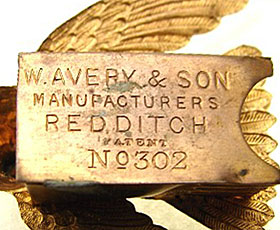
Left: Needle case without gemstones with only "Patented Feb. 24.73" and "No 300" stamped on the bottom (photo from Bunny's Place). Right: Needle case with gemstones with "No 302" and the Avery name but with no patent date (photo from Bunny's Place)
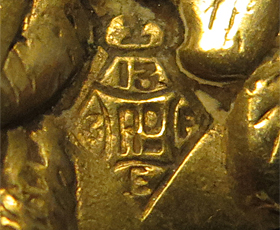
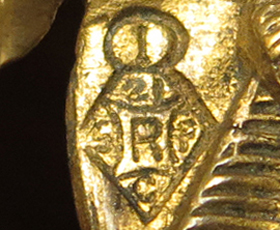
Left: Diamond registration mark on the needle case without gemstones. Right: Diamond registration mark on the needle case with gemstones
Originally there was some question regarding the authenticity of the Bird on a Box needle case with gemstones. After carefully examining photographs of the first known example of this item, we thought the gemstones may have been added later based on the way they were attached. Then in 2014 a second example was sold on eBay, however the number of gemstones was different. The 2014 example had only two gemstones on the outer wings and seven on the tail feathers whereas the earlier version had three on the outer wings and nine on the tail feathers. A third example was discovered in 2016 with the same configuration of gemstones as the one from 2014. Two years later in August 2016 a fourth version was discovered in Germany with three gemstones on the outer wings and eight on the tail. Interesting information about how the Victorians used gemstones to send secret messages can be found in the Miscellaneous section of the right side panel on the Gem needle case web page.
In January 2018, fellow Avery collector, David Chatterley, acquired a fifth example of the Bird on a Box with nine gemstones on the tail feathers and three on the outer wings. David closely examined the way in which the gems were attached to the brass and believed they were attached at the time the needle case was made. David also brought to our attention that the bottom of his needle case contained the words “No 302” whereas examples of this needle case without the gemstones contain “No 300”. As a result of his discovery, we checked all of the photos we had collected of this item over the years and were able to confirm that all of the ones with gemstones contained the number 302 whereas all the ones with the number 300 did not have the gemstones. This new information is evidence that there were originally two different Bird on a Box needle cases, one with gems and one without gems. It seems most likely that a jeweler added the gemstones at the time the needle case was manufactured. Additionally, if we look at the other Avery style needle case registered and manufactured by Jenkins, the Butterfly Filigree, we find “No 301” stamped on it. This suggests Jenkins made the Bird on a Box without the gemstones first, the Butterfly Filigree second and the Bird on a Box with gemstones third.
I finally purchased a Bird on a Box with gemstones for my collection in October 2021. Only after examining it closely and comparing it to the one I had without the gemstones did I discovered something else, the diamond registration marks were different. The one with the gemstones was stamped on the left side and translated to January 21, 1873, whereas the one without the gemstones was stamped on the right side and translated to May 13, 1873. Based on photographs of all six examples with gemstones, four had the diamond mark on the left and two had it on the right. Also, of the ones with gemstones, three had the January 21, 1873 date whereas the diamond marks on the other three were illegible. Of the four known examples without gemstones, three had the diamond mark stamped on the right and one was stamped on the left, one matched the January 21, 1873 date, one had the May 13, 1873 date and the other two were illegible. This is further evidence that there were two slightly different versions of the Bird on a Box needle cases made in 1873. A thorough search of The National Archives, Kew website for all metal designs registered between January and May 1873 was undertaken and only one design for this item was registered by Henry Jenkins & Sons and it was dated February 21, 1873. It is interesting to note that the diamond registration mark for the month of January was the letter C, but for the month of February it was the letter G. Perhaps most of these marks were originally G’s and the wear and tear over almost 150 years made them now look like C’s. This would explain why the date on the diamond registration mark did not match the date the item was actually registered.
The discrepancy in the diamond registration mark which translated to May 13, 1873 could be simply human error. Perhaps the person operating the stamping press used the wrong diamond registration stamp. The fact that none of the translated diamond registration mark dates match the “Patented Feb. 24. 73” date actually stamped on these items or the actual registration date of February 21, 1873 implies this is what happened. Obviously, the person creating the stamp for the patented date misunderstood the day and thought it was 24 instead of 21. Other Avery needle cases designs produced by other companies have been found where the diamond registration mark on the needle case does not match the actual registration documents.
If you have one of these Bird on a Box needle cases, please check the diamond registration mark numbers and letters carefully and send an email to meinket@yahoo.com to let me know what they are as this will help our research.
Photographs of the five other examples with gemstones
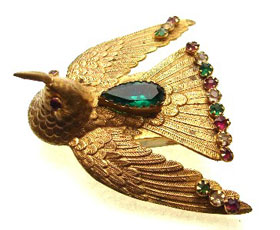
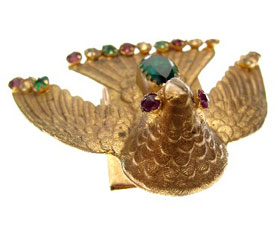
Example 1 - Photographs courtesy of Bunny's Place
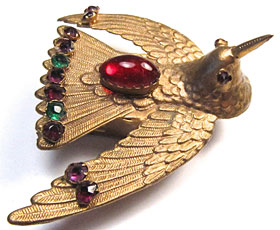
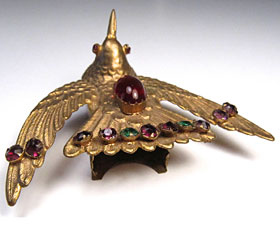
Example 2 - 2014 Photographs from eBay
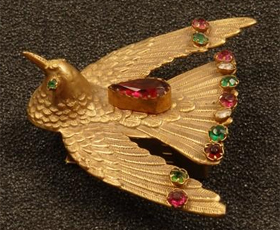
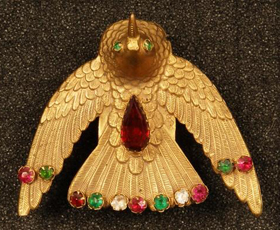
Example 3 - 2016 Photographs from the Internet
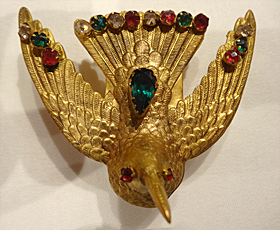
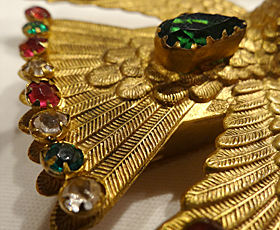
Example 4 - 2016 photographs courtesy of Hans Gruchow (this example has red eyes)
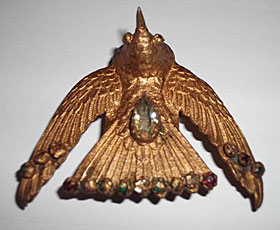
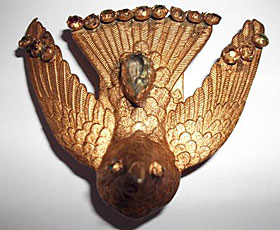
Example 5 - 2018 Photographs courtesy of David Chatterley
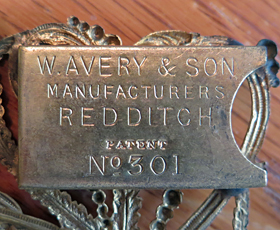
Butterfly Filigree needle case with "No 301" stamped on the bottom





